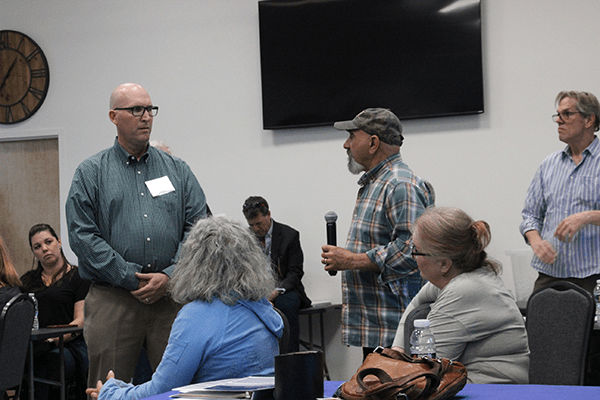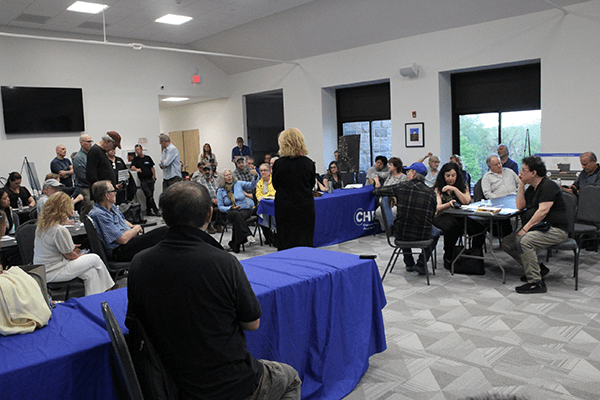|
RCBJ-Audible (Listen For Free)
|
Community Members Ask Questions About Tax Benefits, Construction Schedules, Compensation, Clean Energy
By Andy Milone
STONY POINT – Construction on an environmentally friendly transmission line will soon get underway along an eastern strip of Rockland County.
Now many years in the making, work on the Champlain Hudson Power Express is expected to begin within the next month on Route 9W between Short and Long Clove roads along the Hudson River. The new infrastructure will be installed underneath the road and public and private properties. It’s expected to generate hydroelectric power for New York City by May 2026.
“We’re going to be digging for about the next year up and down Route 9W,” said Paul Weske, vice president of terrestrial construction, in front of a few dozen people Tuesday at a pre-construction open house at the Patriot Hills Senior & Community Center.
“The worst and hardest part of our construction – the digging in Rockland – will be in the first year.”
No obvious hurdles are in sight preventing the public project at this point from moving forward, says a spokesperson, as some in the room were perhaps hoping. Company officials say it will provide 20% of New York City’s electricity. It’s touted as the country’s largest transmission line built entirely underwater and underground.
The line will cover 339 miles and transmit 1250 megawatts of hydroelectric power from Quebec to a substation in Astoria, Queens. In Rockland County, the route spans 7.6 miles, according to Nolan Mazur, director of Department of Transportation management.
Several attendees were residents and business owners who had questions about the potential impact of the one to two years of stop-and-start work.
“There’s so many questions here,” said Joe Brancato of Thiells. “It’s quite frankly astounding to me and believe me I applaud each one of you for your energies and what you’re doing.
“But there are enormous questions that are going to affect families and businesses in this community, and I’m astounded that there isn’t more reveal and more openness about this. That’s just my observation here. I hope it all works out.”
Attendees were provided with responses to their queries, learning, for instance, that there will be daytime and nighttime shifts as well as how some utilities may see disruptions.
“There are some gas service lines to individual residents that will be impacted in the sense that there will be an outage. Those will be coordinated through Orange and Rockland Gas,” said Weske.

Officials hope to move quickly and minimize the impact of the work. They’re not expecting any full road closures and are hoping to maintain access to businesses. However, some residents were skeptical as the construction schedule continues to be formulated.
“We’ll be able to put together a complete schedule when New York state Department of Public Service issues us a full notice to proceed,” said Weske. “At that time, we will have all the major components in place.”
He was unsure whether work would proceed north or south of the starting area as agreements continue to be worked out with private landowners for permanent and temporary easements.
The line comes ashore from the Hudson River in the area of Tomkins Cove in Stony Point, proceeding along Highway 9W to an area near Congers Collision and Rockland Lake Championship Golf Course before submerging back into the waterway.
Kelli Bell, project manager with Coates Field Service, says easements have been acquired from 78% of the 64 private parcels in the county. The company pursues eminent domain as a last resort if not able to voluntarily come to an agreement with landowners. In total, the company’s obtained 90% of the easements from 610 private parcels.
The company has obtained many of the necessary permissions for the project previously awarded to it by the state. They include major ones from the Public Service Commission and New York State Energy Research and Development Authority, as well as other regulatory approvals from the state and federal government.
More than a decade ago, New York called for 100% clean energy by 2040. Hydro-Québec and Blackstone-backed Transmission Developers Inc. are behind the new line answering that call.
“New York has a particularly difficult problem with cleaning up its grid because it’s so tight. There’s no space to build generation. The state has mandates to reach 100% clean energy and so we are a very important project,” said Jennifer Laird-White, senior vice president of external affairs, during introductory remarks.
In return, the impacted residents and business owners will not be getting direct compensation, unless they’re among those giving up an easement. That was an issue for some in the room.
“How many of the businesses on Route 9W are being given money for the fact that their businesses will be disturbed?” asked Susan Filgueras of Tomkins Cove, a board member with Stony Point Action Committee for the Environment. “They will not have ready access and they will lose income, meaning we will lose taxes.”
There have been community benefit and streetscape funds established, totaling $31 million for the municipalities’ right-of-way, said Laird-White.
An official memo passed around by meeting attendees, showed the towns of Stony Point, Haverstraw, and Clarkstown, as well as the villages of West Haverstraw and Haverstraw, and the North Rockland School District each getting anywhere from $3.9 million to $8.2 million.
That same document estimated $4.1 million of property tax revenue for the first year of operation and “moderate” increases year over year; however, the spokesperson noted plans to make payments in lieu of taxes, also known as PILOTs. PILOTs have to be negotiated with and approved by each individual taxing entity and generally provide a steady flow of revenue to the recipients.
The company has hosted several other meetings in the county for the project in the works now for approximately 15 years, though many people said this gathering saw the highest attendance. A state official reached out about setting it up, Laird-White said. The Stony Point Action Committee for the Environment also pushed for it.
Photos: Andy Milone















